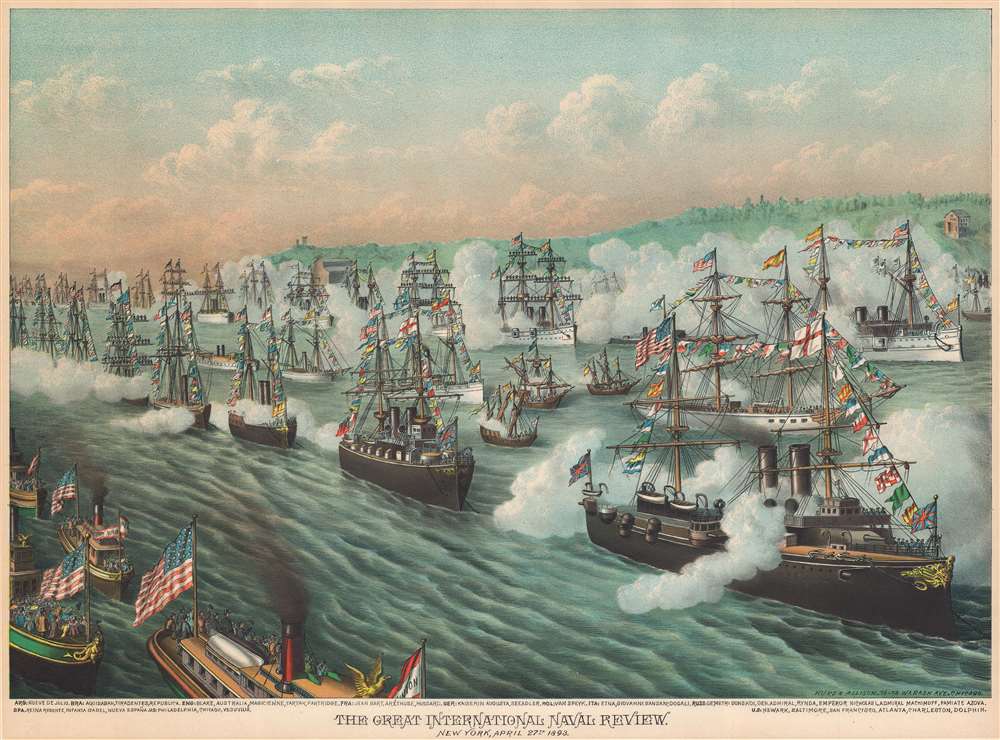1893 Kurz and Allison View of International Naval Review, New York City
IntlNavalReview-kurzallison-1893
Title
1893 (dated) 18.5 x 25 in (46.99 x 63.5 cm)
Description
The 1893 Great Naval Review
Preceding Chicago's Columbian Exposition, ships from nine foreign nations and the United States assembled at Hampton Roads, Virginia, to commemorate Christopher Columbus's arrival in the New World. After a week of festivities in and around Hampton Roads while waiting for the international fleet to assemble, the entire group sailed for New York City on Monday, April 24th, in two columns: one for American vessels and one for ships from foreign nations. After arriving in New York, the vessels anchored in their two-column formation in the Hudson River, along with three replicas of Columbus's ships provided by Spain. The columns stretched from 96th Street to 34th Street and onlookers lined Manhattan's piers and the luckiest (and wealthiest) chartered boats to steam amongst the assembled fleet. President Grover Cleveland, aboard the dispatch boat Dolphin reviewed the assembly that afternoon. One New York writer described the scene:The Hudson shone and sparkled with gala bunting and flashing lights. Guns boomed and roared, whistles shrieked, bands sent martial strains echoing among the iron-walled fortresses, men huzzaed, and women added their glove taps to the triumphant acclaim.Apparently, in a bid to add to the ceremony, demolition workers blasting cliffs among the New York Palisades joined in, providing a series of dynamite blasts that brought down a cliff and added a cloud of dust and debris to the cacophony.
Chromolithography
Chromolithography, sometimes called oleography, is a color lithographic technique developed in the mid-19th century. The process involved using multiple lithographic stones, one for each color, to yield a rich composite effect. Oftentimes, the process would start with a black basecoat upon which subsequent colors were layered. Some chromolithographs used 30 or more separate lithographic stones to achieve the desired product. Chromolithograph color could also be effectively blended for even more dramatic results. The process became extremely popular in the late 19th and early 20th centuries when it emerged as the dominant method of color printing. The vivid color chromolithography produced made it exceptionally effective for advertising and propaganda imagery.Publication History and Census
This view was created and published by Kurz and Allison c. 1893. We note a single cataloged example in OCLC which is part of the collection at the Boston Athenaeum. A second example is part of the Jay T. Last Collection at the Huntington Library, Art Museum, and Botanical Garden.Cartographer
Kurz and Allison (1880 - c. 1905) was an American publishing firm known for its chromolithographs. Founded by Louis Kurz (1835 - 1921) and Alexander Allison, the firm was based at 267-269 Wabash Avenue in Chicago. In the partnership, it is known that Kurz, an Austrian immigrant, was the lithographer and it is presumed that Allison provided the financial backing. The firm is most well-known for its series of thirty-six battle scenes from the American Civil War. At the time of their publication, the late 1880s and early 1890s, a general nostalgia was prevalent among Civil War veterans (of which Kurz was one), and evidently the company was trying to capitalize on the sentiment. Kurz and Allison's Civil War prints were not the first such prints to be issued, but they were by far the most popular. In a style reminiscent of Currier and Ives, Kurz and Allison lithographs are not meant to be historical representations, and even, from time to time, included historical inaccuracies. Even so, 'prints depicting the Civil War battles by Kurz and Allison are among the most sought-after collectibles of Civil War enthusiasts.' Their prints are also notable for featuring African-American soldiers, a rarity for the era. After the outbreak of the Spanish-American War, the firm published views from famous battles and continued doing so for the campaigns of the Philippine-American War and the Russo-Japanese War. More by this mapmaker...

